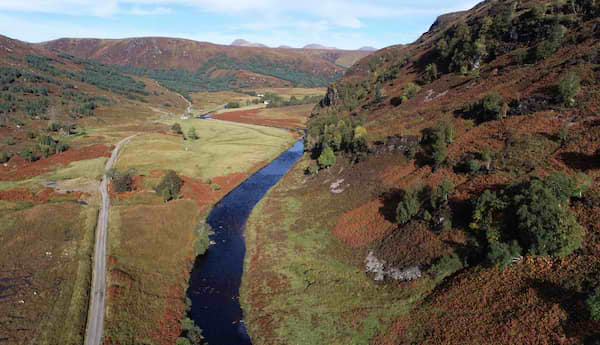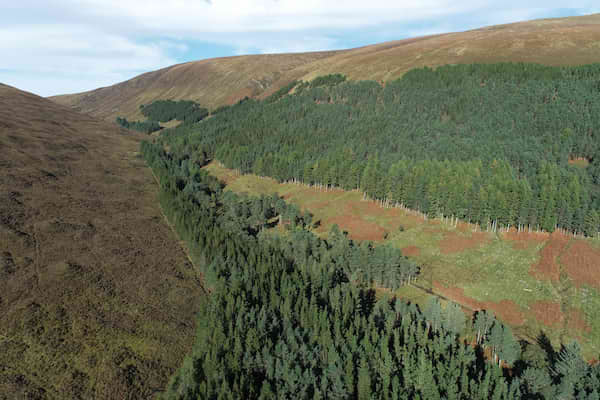Nature restoration at a landscape scale
Cabuie is a breathtaking mountainous region spanning 15,502 hectares along Scotland's northwest coast, encompassing the estates of Cabuie, Bruachaig, and Fada.
Our vision: A landscape in which nature is allowed to develop and thrive to its full potential through natural regeneration and recovery.
About Cabuie
Peatland, heathland and rough grassland currently dominate the hillslopes of Cabuie.
This vast and wild landscape is intersected by deep-sided gullies where occasional pockets of species-rich native woodlands survive.
Hill lochans host rare bird species, such as the red throated diver.
Cabuie is situated in Wester Ross, an area recognised for its international importance to nature conservation and landscape value.
Although wild and remote, the habitats of Cabuie are in poor condition. Their health has been damaged by activities such as overgrazing, burning, drainage and erosion over hundreds of years.
Building on the pioneering peatland restoration carried out over the past decade, our ambition at Cabuie is to create conditions where native plants and animals can once again thrive in the landscape.

The Restoration Programme
A multi-year nature restoration programme for Cabuie aims to realise our long-term vision of a landscape where nature can develop and thrive.
What are the programme's goals?
- Protect, restore and expand native habitats and species, including native woodland, peatlands and freshwater through addressing key pressures and threats such as overgrazing and drainage.
- Contribute to the mitigation of climate change by securing the carbon contained within peatlands and sequestering carbon in recovering woodlands.
- Contribute to the local economy and enhance the cultural value of the landscape to the benefit of the community and visitors to the area.
What will the programme do?
- Establish new native woodland, principally through creating conditions for natural regeneration, with a target of increasing tree coverage from less than 1% to more than 25%. No commercial forestry will take place in the area.
- Restore all degraded peatlands.
- Work collaboratively with the local fisheries management group to identify priority locations for riparian planting and the long-term restoration of natural hydrology.
- Reduce and maintain deer populations at a biologically and environmentally sustainable level, informed by science.
- Monitor the recovery of nature through a suite of metrics and indicators, reporting these in a clear, open and transparent way.
- Welcome recreational public access and consider path repair or construction on popular routes.
With time and persistence, native nature can return here.
Native woodland regeneration
There are 17 woodland refuges across Cabuie, covering just 90 hectares. These remnants can be traced back to an unbroken history of woodland that first emerged after the end of the last Ice Age.

There are an estimated 43,000 wild trees across Cabuie, mostly surviving on inaccessible crags and in ravines where they have remained out of the reach of browsing animals.
The remnants retain a high level of biodiversity, with 22 species of tree and 88 refugial species typically associated with woodland.
Although seven of the tree species were found to have very low population levels, there is an average of 600 seedlings per hectare, indicating the potential for the ancient woodlands to recover and then expand through natural regeneration.
Our plan for woodland regeneration
Over time, natural regeneration can restore biodiversity and habitat for woodland wildlife over entire landscapes when conditions are right.
Over years and decades, this expansion of nature will gain momentum as more parent trees establish themselves, sending increasing volumes of wild seed into the landscape and slowly building the fertility of nutrients cycling back into the soil.
Alongside this woodland expansion, regeneration in Cabuie’s peatlands and flower-rich upland plant communities is also expected.
Wild salmon regeneration
The rivers that flow from Cabuie do so through a landscape of international importance for nature conservation. The Bruachaig River sources from the centre of Cabuie and is one of two main tributaries of the Kinlochewe River, the main wild salmon and sea trout spawning stream within the River Ewe-Loch Maree system.
For Wester Ross, wild Atlantic salmon (Salmo salar) are iconic. They also provide an ecological connection between the land, freshwaters and the sea through their ability to deliver nutrients of marine origin into headwater streams. Wild salmon can be a keystone part of the ecosystem.
The challenge
The salmon and sea trout fisheries of the River Ewe-Loch Maree system were once some of the most prolific in Northwest Scotland. Many notable fish in terms of size or age were recorded in the 20th century. From the 1980s, catches declined and a self-sustaining wild salmon population is thought to have died out on the estate. In 2023, the IUCN added the Atlantic salmon to the endangered species list for Great Britain.
While the Bruachaig is considered to have good ecological potential, it has been heavily modified by water abstraction for hydro developments and has lost much bankside tree cover, which is crucial for providing shade and nutrition for fish populations.
Reports commissioned on the viability of the Bruachaig River to support salmon indicate that with habitat improvement measures, the watercourse may be able to support 4,000 to 8,000 additional young salmon beyond those currently in the River Ewe–Loch Maree system, representing an increase of up to 20%.

Restoring riparian woodlands at Cabuie will play a major role in this restoration project.
"More and more Scottish Highland estates are recognising there is a nature crisis. A few are also taking bold action to restore lost forests, damaged peatlands and impoverished freshwater habitats. In doing so they will lock up precious carbon, regenerate flora and fauna and help nature thrive again.
Centuries of overgrazing and bungled attempts to drain peat bogs are the main drivers of nature loss, so it's fantastic to see Cabuie focusing on addressing these two key threats. In the absence of natural predators, deer numbers have reached all time highs. Seedlings of Scot's pine, birch, willows and rowan - remnants from the wildwood of Caledon - are eaten before they reach even knee height. By reducing deer numbers, Cabuie will give these trees a chance to become the forests of the future. Similarly, by re-wetting damaged peatlands, the rich mosaic of colourful Sphganum mosses will return, providing breeding and feeding grounds for wading birds and accreting carbon as they lay down peat.
Cabuie's vision is bold and ambitious and much needed to address the interlinked nature and climate crises. Let's hope more estates follow their lead in the coming years."
"Globally and in Scotland, nature is in decline and we face a climate emergency. Biodiversity loss and climate change are intrinsically linked, and protecting and restoring land for nature is a crucial part of the solution to both.
Woodland restoration and expansion has been at the heart of our management of Beinn Eighe National Nature Reserve for over 70 years, and encouraging the ancient woodlands to develop through natural regeneration, has been a key part of this endeavour. At Beinn Eighe NNR, we will continue to work with all our partners, neighbours and the local community to enhance and expand the largest remnant of ancient Caledonian pinewood in the northwest of Scotland."